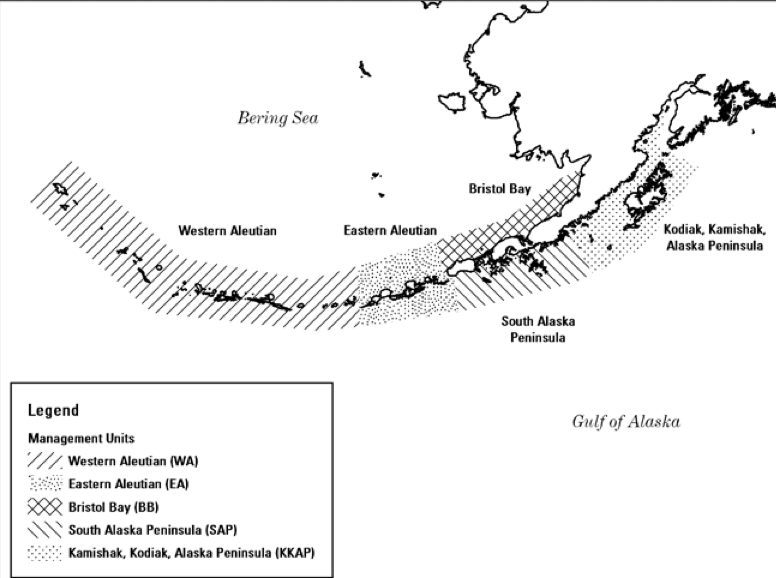You Otter Think About Saving the Northern Sea Otters
Amanda Ahearn

Source: http://www.flickr.com/photos/marlinharms/7370629006/
The words “sea otter” usually come with a
positive connotation. People are led to talk about how cute they think sea
otters are or maybe how they have never seen one in person but really want to.
Rarely does the topic of species endangerment come up. Previous to this class,
I myself had no knowledge that the sea otter was an endangered species. For
this specific post, I will be focusing my efforts on the recovery plan for the
Northern Sea Otter located in Southwest Alaska.
 |
| Source: http://www.flickr.com/photos/marlinharms/7370629006/ |
Description and Ecology
Sea otters
are the largest mustelid with males measuring up to 45 kg and females measuring
up to 36 kg. Sizes vary among different population and may correlate with the
amount of food available to said population. The taxonomy of the sea otter is
based on the morphology of its skull. The sea otter is in the order Carnivora.
There are two sea otter lineages as well: Enphydriodon and Enphydritherium.
Geographic and Population Changes
 |
| Management Units. Source: http://ecos.fws.gov/docs/recovery_plan/Recovery%20Plan%20SW%20AK%20DPS%20Sea%20Otter%20Aug13.pdf |
The
Northern Sea Otter occurs only in the North Pacific Ocean, however, it does
have a historical geographic range. They used to be located around the Pacific
Rim between Central Baja California and Northern Japan. The animal uses most of
the coastal marine habitats that are found in its specific range. This includes
bays, estuaries and offshore islands. They can also be found in waters a few
kilometers off shore. They tend to forage in bottom types such as fine mud and
sand. Researchers have found a positive correlation between shoreline
complexity and sea otter density.
Very little is known about the long-term patterns of sea
otter abundance. It is suggested, however, that indigenous people of the North
Pacific made use of the sea otter, which could have had a direct influence on
the abundance. The abundance of sea otters was pretty stable until the
beginning of the 20th century when the population was reduced to a
few thousand individuals. They were then reintroduced in the 1960s and 1970s in
southeast Alaska, British Columbia, Washington and Oregon. In 1989, there was a
dramatic decline of sea otters in Aleutian Archipelago due to an Exxon Vladez
oil spill. The effects lasted well into the 1990s. Since the 1990s, the sea
otter population has grown 2-3% per year; slow and steady wins the race. The
most significant declines in sea otter populations occurred in the 1990s and
from 2007-2009.
Listing Date and Type of Listing
The Northern Sea Otter was listed on the Endangered Species List on August 9, 2005 as a threatened species.
 |
| Source:http://wildwhales.org/killer-whale/ |
The species has many threats that could be a detriment to
the population. One of the major threats is that of predation. Some of the
species that threaten sea otters are bald eagles, white sharks, terrestrial
carnivores and killer whales. Other less threatening but still important
threats include infectious disease, biotoxins, contaminants, oil spills, food
limitation, bycatch/entanglement, subsistence harvest, habitat concerns and
illegal take. All of these elements pose
a threat to the sea otter, which is a main reason, why a recovery plan was
created.
 |
| http://www.treehugger.com/natural-sciences/it-took-25-years-sea-otters-get-over-exxon-valdez-oil-spill.html |
Recovery Plan
The goal of the recovery plan created is to control, reduce or eliminate threats that could harm the survival of the sea otter population. There are three main objectives to the recovery plan. They are: to achieve a self-sustaining sea otter population, maintain enough sea otters so that they can have a useful role in their ecosystem ad to alleviate threats. In order to go forward with this plan, researchers must monitor the population, understand habitat needs, manage human impacts, evaluate the roles of disease and predation, and to, finally, implement the plan entirely. Hopefully after all of this, the sea otter population will thrive!
No comments:
Post a Comment